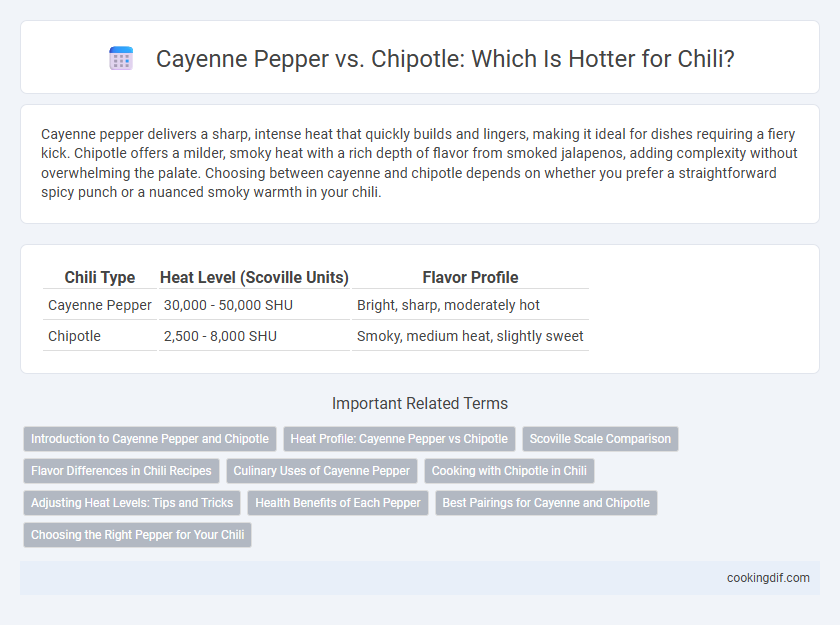Cayenne pepper delivers a sharp, intense heat that quickly builds and lingers, making it ideal for dishes requiring a fiery kick. Chipotle offers a milder, smoky heat with a rich depth of flavor from smoked jalapenos, adding complexity without overwhelming the palate. Choosing between cayenne and chipotle depends on whether you prefer a straightforward spicy punch or a nuanced smoky warmth in your chili.
Table of Comparison
| Chili Type | Heat Level (Scoville Units) | Flavor Profile |
|---|---|---|
| Cayenne Pepper | 30,000 - 50,000 SHU | Bright, sharp, moderately hot |
| Chipotle | 2,500 - 8,000 SHU | Smoky, medium heat, slightly sweet |
Introduction to Cayenne Pepper and Chipotle
Cayenne pepper, derived from dried and ground red chili peppers, typically measures between 30,000 to 50,000 Scoville Heat Units (SHU), offering a sharp and intense heat suitable for a wide range of spicy dishes. Chipotle peppers are smoked and dried jalapenos, with a milder heat ranging from 2,500 to 8,000 SHU, imparting a smoky flavor along with moderate spiciness. Both cayenne and chipotle peppers are popular in chili recipes, but cayenne delivers more intense heat while chipotle adds rich smokiness and depth.
Heat Profile: Cayenne Pepper vs Chipotle
Cayenne pepper delivers a sharp, intense heat ranging from 30,000 to 50,000 Scoville Heat Units (SHU), making it significantly spicier than chipotle. Chipotle peppers, smoked and dried jalapenos, typically register between 2,500 and 8,000 SHU, offering a milder but smoky heat profile. The higher capsaicin concentration in cayenne makes it ideal for intense heat seekers, while chipotle provides a balanced smoky warmth suitable for nuanced dishes.
Scoville Scale Comparison
Cayenne pepper typically registers between 30,000 to 50,000 Scoville Heat Units (SHU), offering a sharp, intense heat ideal for adding fiery spice to dishes. Chipotle peppers, dried and smoked jalapenos, usually rank lower on the Scoville Scale, ranging from 2,500 to 8,000 SHU, providing a milder heat with a distinctive smoky flavor. Comparing their Scoville ratings highlights cayenne as significantly hotter, making it preferable for those seeking a more potent chili intensity.
Flavor Differences in Chili Recipes
Cayenne pepper delivers a sharp, intense heat that elevates the spice level in chili recipes, while chipotle offers a milder, smoky warmth with subtle hints of sweetness and earthiness. The bright, clean heat of cayenne complements fresh tomato bases and green chilies, enhancing the overall spiciness without overpowering other flavors. Chipotle's rich, smoky profile adds depth and complexity, balancing savory meats and beans, making it ideal for chili recipes aiming for a smoky, layered taste.
Culinary Uses of Cayenne Pepper
Cayenne pepper delivers a sharp, intense heat rating of 30,000 to 50,000 Scoville Heat Units, making it significantly hotter than chipotle peppers, which range from 2,500 to 8,000 SHU. Cayenne is widely used in culinary applications to add vibrant spice and color to dishes such as soups, stews, sauces, and spice blends, often serving as a primary heat source in Cajun and Creole cuisines. Its fine powder form allows for easy incorporation into dry rubs and marinades, enhancing flavor profiles without overpowering the dish.
Cooking with Chipotle in Chili
Chipotle peppers provide a smoky, moderate heat that enhances chili with rich depth without overwhelming spice levels, making them ideal for balanced, flavorful dishes. In contrast, cayenne peppers deliver intense, sharp heat that can dominate the palate if not carefully measured. Cooking with chipotle in chili adds complexity and warmth, elevating the overall taste profile while maintaining a manageable spiciness.
Adjusting Heat Levels: Tips and Tricks
Cayenne pepper delivers a sharp, intense heat with Scoville Heat Units (SHU) ranging from 30,000 to 50,000, ideal for boosting spiciness without altering flavor profiles significantly. Chipotle peppers, smoked and dried jalapenos, provide a milder heat of 2,500 to 8,000 SHU combined with smoky, earthy notes, making them perfect for adding depth alongside moderate heat. To adjust heat levels, start with small increments of cayenne for pure heat and balance with chipotle to introduce smoky complexity while gradually achieving desired spiciness.
Health Benefits of Each Pepper
Cayenne pepper delivers intense heat with a high concentration of capsaicin, promoting metabolism boost, pain relief, and cardiovascular health. Chipotle peppers offer a milder, smoky heat, rich in antioxidants and vitamins A and C, supporting immune function and anti-inflammatory effects. Both peppers contribute unique health benefits linked to their capsaicin content and nutrient profiles, enhancing overall wellness through different intensities and flavors.
Best Pairings for Cayenne and Chipotle
Cayenne pepper offers intense heat with a bright, sharp flavor, making it ideal for spicing up soups, stews, and spicy meat dishes. Chipotle provides a moderate smoky heat that complements barbecue sauces, chili con carne, and roasted vegetables. Best pairings for cayenne include Mexican salsas, hot wings, and Cajun seasoning blends, while chipotle excels with grilled meats, creamy dips, and Southwestern cuisine.
Choosing the Right Pepper for Your Chili
Cayenne pepper delivers a sharp, intense heat around 30,000 to 50,000 Scoville Heat Units (SHU), perfect for those seeking a fiery chili experience. Chipotle peppers, smoked and dried jalapenos, offer a moderate heat level of 2,500 to 8,000 SHU with a rich, smoky flavor that adds depth without overpowering the dish. Selecting cayenne intensifies spiciness quickly, while chipotle contributes complexity, making the choice essential based on desired heat and taste profile in your chili.
Cayenne Pepper vs Chipotle for heat Infographic

 cookingdif.com
cookingdif.com